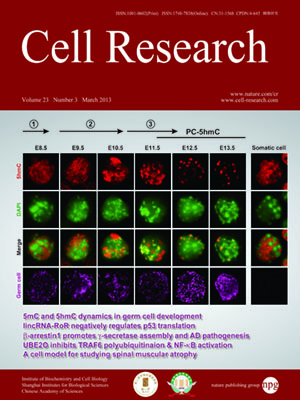
Volume 23, No 3, Mar 2013
ISSN: 1001-0602
EISSN: 1748-7838 2018
impact factor 17.848*
(Clarivate Analytics, 2019)
Volume 23 Issue 3, March 2013: 423-435
ORIGINAL ARTICLES
hSSB1 regulates both the stability and the transcriptional activity of p53
Shuangbing Xu1,*, Yuanzhong Wu1,*, Qiong Chen1, Jingying Cao1, Kaishun Hu1,Jianjun Tang1, Yi Sang1, Fenju Lai1, Li Wang1, Ruhua Zhang1, Sheng-Ping Li2, Yi-Xin Zeng 1, Yuxin Yin3 and Tiebang Kang1
1State Key Laboratory of Oncology in South China, Department of Experimental Research, Sun Yat-Sen University Cancer Center, Guangzhou 510060, Guangdong, China
2Department of Liver Cancer, Sun Yat-Sen University Cancer Center, Guangzhou 510060, Guangdong, China
3Institute of System Biomedicine, School of Basic Medical Sciences, Peking University, Beijing 100191, China
Correspondence: Tiebang Kang(kangtb@mail.sysu.edu.cn)
The tumor suppressor p53 is essential for several cellular processes that are involved in the response to diverse genotoxic stress, including cell cycle arrest, DNA repair, apoptosis and senescence. Studies of the regulation of p53 have mostly focused on its stability and transactivation; however, new regulatory molecules for p53 have also been frequently identified. Here, we report that human ssDNA binding protein SSB1 (hSSB1), a novel DNA damage-associated protein, can interact with p53 and protect p53 from ubiquitin-mediated degradation. Furthermore, hSSB1 also associates with the acetyltransferase p300 and is required for efficient transcriptional activation of the p53 target gene p21 by affecting the acetylation of p53 at lysine382. Functionally, the hSSB1 knockdown-induced abrogation of the G2/M checkpoint is partially dependent on p53 or p300. Collectively, our results indicate that hSSB1 may regulate DNA damage checkpoints by positively modulating p53 and its downstream target p21.
Cell Research (2013) 23:423–435; doi:10.1038/cr.2012.162; published online 27 November 2012
FULL TEXT | PDF
Browse 2066


